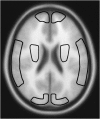Arterial spin labeling perfusion MRI at multiple delay times: a correlative study with H(2)(15)O positron emission tomography in patients with symptomatic carotid artery occlusion
- PMID: 19809464
- PMCID: PMC2949108
- DOI: 10.1038/jcbfm.2009.204
Arterial spin labeling perfusion MRI at multiple delay times: a correlative study with H(2)(15)O positron emission tomography in patients with symptomatic carotid artery occlusion
Abstract
Arterial spin labeling (ASL) perfusion magnetic resonance imaging (MRI) with image acquisition at multiple inversion times is a noninvasive ASL technique able to compensate for spatial heterogeneities in transit times caused by collateral blood flow in patients with severe stenosis of the cerebropetal blood vessels. Our aim was to compare ASL-MRI and H(2)(15)O positron emission tomography (PET), the gold standard for cerebral blood flow (CBF) assessment, in patients with a symptomatic internal carotid artery (ICA) occlusion. Fourteen patients (63+/-14 years) with a symptomatic ICA occlusion underwent both ASL-MRI and H(2)(15)O PET. The ASL-MRI was performed using a pulsed STAR labeling technique at multiple inversion times within 7 days of the PET. The CBF was measured in the gray-matter of the anterior, middle and posterior cerebral artery, and white-matter. Both PET and ASL-MRI showed a significantly decreased CBF in the gray-matter of the middle cerebral artery in the hemisphere ipsilateral to the ICA occlusion. The average gray-matter CBF measured with ASL-MRI (71.8+/-4.3 mL/min/100 g) was higher (P<0.01) than measured with H(2)(15)O PET (43.1+/-1.0 mL/min/100 g). In conclusion, ASL-MRI at multiple TIs is capable of depicting areas of regions with low CBF in patients with an occlusion of the ICA, although a systematic overestimation of CBF relative to H(2)(15)O PET was noted.
Figures




References
-
- Alsop DC, Detre JA. Reduced transit-time sensitivity in noninvasive magnetic resonance imaging of human cerebral blood flow. J Cereb Blood Flow Metab. 1996;16:1236–1249. - PubMed
-
- Bamford JM, Sandercock PAG, Warlow CP, Slattery J. Interobserver agreement for the assessment of handicap in stroke patients. Stroke. 1989;20:828. - PubMed
-
- Barth M, Moser E. Proton NMR relaxation times of human blood samples at 1.5 T and implications for functional MRI. Cell Mol Biol (Noisy-le-grand) 1997;43:783–791. - PubMed
-
- Boellaard R, Knaapen P, Rijbroek A, Luurtsema GJ, Lammertsma AA. Evaluation of basis function and linear least squares methods for generating parametric blood flow images using 15O-water and positron emission tomography. Mol Imaging Biol. 2005;7:273–285. - PubMed
-
- Boellaard R, van Lingen A, van Balen SC, Hoving BG, Lammertsma AA. Characteristics of a new fully programmable blood sampling device for monitoring blood radioactivity during PET. Eur J Nucl Med. 2001;28:81–89. - PubMed
Publication types
MeSH terms
Substances
LinkOut - more resources
Full Text Sources
Miscellaneous

